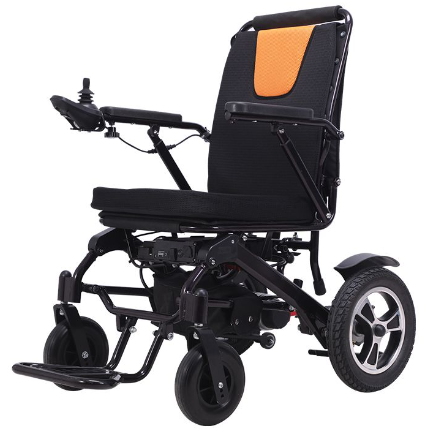Aug. 26, 2022
A motorized wheelchair, powerchair, electric wheelchair or electric-powered wheelchair (EPW) is defined as a wheelchair that is propelled utilizing an electric motor rather than manual power. Motorized wheelchairs are useful for those unable to propel a manual wheelchair, or who may need to use a wheelchair for distances or over terrain which would be fatiguing in a manual wheelchair. They may also be used not just by people with 'traditional' mobility impairments, but also by people with cardiovascular and fatigue-based conditions.

Powerchairs are generally four-wheeled or six-wheeled and non-folding, however some folding designs exist and other designs may have some ability to partially dismantle for transit. Four general styles of powerchair drive systems exist: front, center or rear-wheel drive and all-wheel drive. Powered wheels are typically somewhat larger than the trailing/castoring wheels, while castoring wheels are typically larger than the castors on a manual chair. Center wheel drive powerchairs have castors at both front and rear for a six-wheel layout.
A powerchair can be used by someone who hasn't got the dexterity or mobility, perhaps, to drive a mobility scooter due to arm, hand, shoulder or more general disabling conditions, and do not have the leg strength to propel a manual chair with their feet. EPWs can offer various powered functions such as tilt, recline, leg elevation, seat elevation, and others useful or necessary to health and function. A powerchair user might also have special seating or arm and leg rest requirements that are better served by a powerchair than a mobility scooter.
The technology involved in electric wheelchairs is similar to that of mobility scooters, and some powerchair manufacturers are offering models that look more like a mobility scooter than a traditional wheelchair.
Today you will find three general styles of electric-powered chairs (EPWs). Each style of wheelchair has particular handling characteristics. EPWs are also divided by seat type; some models resemble manual chairs, with a sling-style seat and frame, whereas others have 'captain's chair' seating like that of an automobile. EPWs run the gamut from small and portable models, which can be folded or disassembled, to large and heavy full-featured chairs (these are often called 'rehab' chairs).
The user typically controls speed and direction by operating a joystick on a controller. Many other input devices can be used if the user lacks coordination or the use of the hands or fingers, such as chin controls and puff/sip scanners.
Powerchairs are usually controlled by a joystick on the armrest, which can be fitted on either armrest to suit left or right-handed use. The arm rest can usually be swung out of the way so that the user can get closer to a desk or table, for example.
If a joystick control isn't appropriate for the user's needs, there are other methods of operating the powerchair, including a head controller, a sip and puff tube, fingertip control or foot control for those with C2-C3 spinal cord lesions or head injuries (the user blows into a tube located near the mouth, which controls the movement of the chair).
A powerchair or electric wheelchair can bring independence and freedom to those currently reliant on others. Once you have decided on a powerchair rather than a mobility scooter or wheelchair, there are still plenty of other choices to be made. Including the price, the style and size of the powerchair, how portable the powerchair is, and how far it goes between charges.
Traditionally, power-chairs were not designed to be transported, and so were very difficult to dismantle. However, nowadays, most electric wheelchairs are transportable, and some are effortless to dismantle. Powerchairs are using technology and features found on mobility scooters such as easy to remove battery packs, and easy to dissemble components that may mean the user doesn't need any additional help to transport or recharge the electric wheelchair.
Powerchairs are usually more customizable than disabled scooters, and can offer different types of control method and seating. For example, the range of the powerchair between charges may not be as important as it's having an electric lift so that you can reach shelves or cupboards. It might be more important that it is available with a specialist seat, rather than dismantling to fit in the car.
For more information, feel free to contact us.
